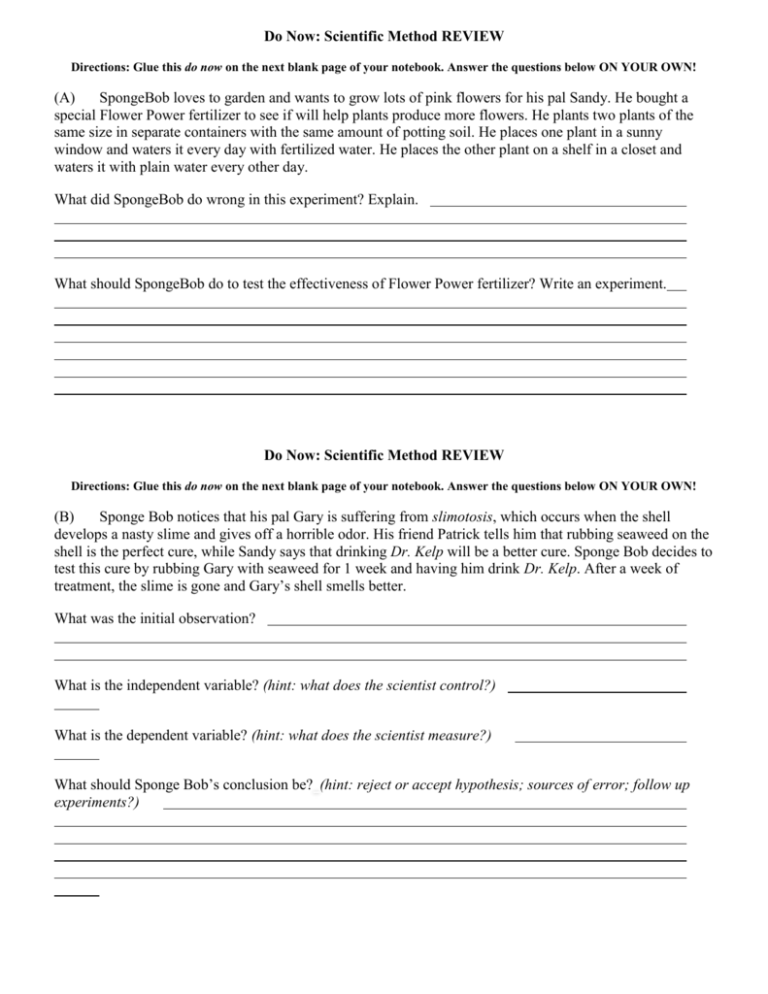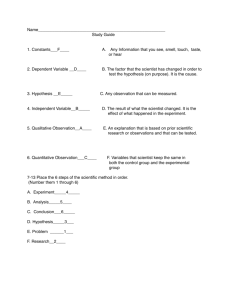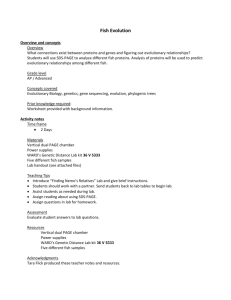Do Now: Scientific Method REVIEW Directions: Glue this do now on
advertisement

Do Now: Scientific Method REVIEW Directions: Glue this do now on the next blank page of your notebook. Answer the questions below ON YOUR OWN! (A) SpongeBob loves to garden and wants to grow lots of pink flowers for his pal Sandy. He bought a special Flower Power fertilizer to see if will help plants produce more flowers. He plants two plants of the same size in separate containers with the same amount of potting soil. He places one plant in a sunny window and waters it every day with fertilized water. He places the other plant on a shelf in a closet and waters it with plain water every other day. What did SpongeBob do wrong in this experiment? Explain. What should SpongeBob do to test the effectiveness of Flower Power fertilizer? Write an experiment. Do Now: Scientific Method REVIEW Directions: Glue this do now on the next blank page of your notebook. Answer the questions below ON YOUR OWN! (B) Sponge Bob notices that his pal Gary is suffering from slimotosis, which occurs when the shell develops a nasty slime and gives off a horrible odor. His friend Patrick tells him that rubbing seaweed on the shell is the perfect cure, while Sandy says that drinking Dr. Kelp will be a better cure. Sponge Bob decides to test this cure by rubbing Gary with seaweed for 1 week and having him drink Dr. Kelp. After a week of treatment, the slime is gone and Gary’s shell smells better. What was the initial observation? What is the independent variable? (hint: what does the scientist control?) What is the dependent variable? (hint: what does the scientist measure?) What should Sponge Bob’s conclusion be? (hint: reject or accept hypothesis; sources of error; follow up experiments?) What is the dependent variable? week After 2 weeks 24 9 33 17 What should Larry’s conclusion be? Do Now: Scientific Method REVIEW Directions: Glue this do now on the next blank page of your notebook. Answer the questions below ON YOUR OWN! 4 – Microwave Miracle Patrick believes that fish that eat food exposed to microwaves will become smarter and would be able to swim through a maze faster. He decides to perform an experiment by placing fish food in a microwave for 20 seconds. He has the fish swim through a maze and records the time it takes for each one to make it to the end. He feeds the special food to 10 fish and gives regular food to 10 others. After 1 week, he has the fish swim through the maze again and records the times for each. What was Patrick’s hypothesis? Which fish are in the control group? What is the independent variable? What is the dependent variable? Look at the results in the charts. What should Patrick’s conclusion be? Answer Key (A) SpongeBob did not provide both plants with the same amount of water and sunshine. In order to test the fertilizer by T. Trimpe 2003 http://sciencespot.net/ correctly, both plants should have been Worksheet placed increated the sunny window and watered every day with the same amount of water. The only difference between the two plants should have been the fertilizer - one plant would be watered with the water with fertilizer and the other would be watered with plain water. Answers will vary. Experiments should address the problems in SpongeBob’ s experiment. Further testing would be needed to make sure the results were not due to other factors. (B) Slimotosis What was the initial observation? Slimotosis on Gary’ s shell What is the independent variable? Cures (Seaweed and Dr. Kelp) What is the dependent variable? Slime and odor What should Sponge Bob’s conclusion be? Although Gary’s symptoms have disappeared, it is not known which cure was the one that worked. He should redo the experiment and include a control group as well as two other testing groups for each of the proposed cures. 4 – Microwave Miracle What was Patrick’s hypothesis? He hypothesized that feeding fish microwaved food would make them become smarter. Which fish are in the control group? The fish that eat regular food What is the independent variable? Microwaved food What is the dependent variable? Time required to complete the maze. Look at the results in the charts. What should Patrick’s conclusion be? According to the data, all but two fish in each group decreased their time through the maze. The special food does not appear to be a big factor in helping fish become smarter. Note: Of the fish that did improve their times, the fish that were fed the special food averaged a 9.625 seconds decrease in their times compared to an average decrease of 6.625 seconds in the fish group that received the regular food. This does show a slight improvement for the microwaved food group, but not enough to prove that his hypothesis was correct. More testing would need to be done.










